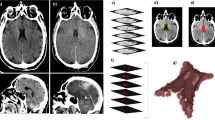Abstract
This study investigated the value of both gross features and histological findings for grading of brain swelling. For this purpose, the grooving of the temporal gyri (unci) as well as the extension of the cones at the basal part of the cerebellum were measured in 42 brains obtained at autopsy. Furthermore, the distension of perivascular spaces in tissue samples from seven different regions of the brains was evaluated histologically, assisted by an automatic image processing and analysis system. In each individual, the normal range of brain weight was calculated on the basis of the body height, using the formulae by Röthig and Schaarschmidt. The difference between this calculated (normal) value and the brain weight evaluated at autopsy was considered as a reliable criterion for the grade of brain swelling. There was no statistical evidence of a positive correlation between the various parameters. Hence, it can be concluded that both gross section and histological findings are of minimal significance for grading of brain swelling.






Similar content being viewed by others

References
Feigin I (1967) Sequence of pathologic changes in brain edema. In: Klatzko I, Seitelberger F (eds) Brain edema. Springer, Berlin Heidelberg New York, pp 129–151
Feigin I, Popoff N (1962) Neuropathological observations on cerebral edema. Arch Neurol 6:151–160
Fisher CM (1984) Acute brain herniation—a revised concept. Semin Neurol 4:417–421
Fisher CM (1995) Brain herniation: a revision of classical concepts. Can J Neurol Sci 22:83–91
Hausmann R, Betz P (2001) Course of glial immunoreactivity for vimentin, tenascin and α1-antichymotrypsin after traumatic injury to human brain. Int J Leg Med 114:338–342
Hausmann R, Rieß R, Fieguth A, Betz P (2000) Immunohistochemical investigations on the course of astroglial GFAP expression following human brain injury. Int J Leg Med 113:70–75
Kibayashi K, Shojo H (2003) Heat-induced immunoreactivity of tau protein in neocortical neurons of fire fatalities. Int J Leg Med 117:282–286
Long DM, Hartmann JF, French LA (1966) The ultrastructure of human cerebral edema. J Neuropathol Exp Neurol 25:373–395
Madro R, Chagowski W (1987) An attempt at objectivity of post mortem diagnostic of brain oedema. Forensic Sci Int 35:125–129
Manz HJ (1974) The pathology of cerebral edema. Human Pathol 5:291–313
Matschke J, Tsokos M (2005) Sudden unexpected death due to undiagnosed glioblastoma. Report of three cases and review of the literature. Int J Leg Med DOI: 10.1007/s00414-005-0551-y
Meyer A (1920) Herniation of the brain. Arch Neurol Psychiatr 4:387–400
Meyermann R, Engel S, Wehner HD, Schlüsener HJ (1997) Microglial reactions in severe closed head injury. In: Oehmichen M, König HG (eds) Neurotraumatology—biomechanic aspects, cytologic and molecular mechanisms. Schmidt-Römhild, Lübeck, pp 261–278
Oehmichen M, Gencic M, Grüninger H (1979) Prae- und postmortale intracerebrale Plasmadiffusion. Lichtmikroskopische Untersuchungen am Hirnoedem. Beitr Gerichtl Med 37:271–275
Röthig W (1976) The so-called pressure zone of the cerebellum. Gegenbaurs Morphol Jahrb 122:882–907
Röthig W, Schaarschmidt W (1977) Lineare Zusammenhänge zwischen Körperlänge und Hirnmasse. Gegenbaurs Morphol Jahrb 123:208–213
Saukko P, Knight B (2004) Head and spinal injuries. In: Saukko P, Knight B (eds) Knight's forensic pathology. Arnold, London, pp 174–221
Scheinker IM (1945) Transtentorial herniation of the brain stem: a characteristic clinicopathologic syndrome: pathogenesis of hemorrhages in the brain stem. Arch Neurol Psychiatr 53:289–298
Scheinker IM (1947) Cerebral swelling: histopathology, classification and clinical significance of brain edema. J Neurosurg 4:255–275
Yates AJ, Thelmo W, Pappius HM (1975) Postmortem changes in the chemistry and histology of normal and edematous brains. Am J Pathol 79:555–564
Author information
Authors and Affiliations
Corresponding author
Rights and permissions
About this article
Cite this article
Hausmann, R., Vogel, C., Seidl, S. et al. Value of morphological parameters for grading of brain swelling. Int J Legal Med 120, 219–225 (2006). https://doi.org/10.1007/s00414-005-0021-6
Received:
Accepted:
Published:
Issue Date:
DOI: https://doi.org/10.1007/s00414-005-0021-6



